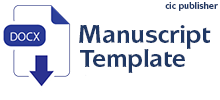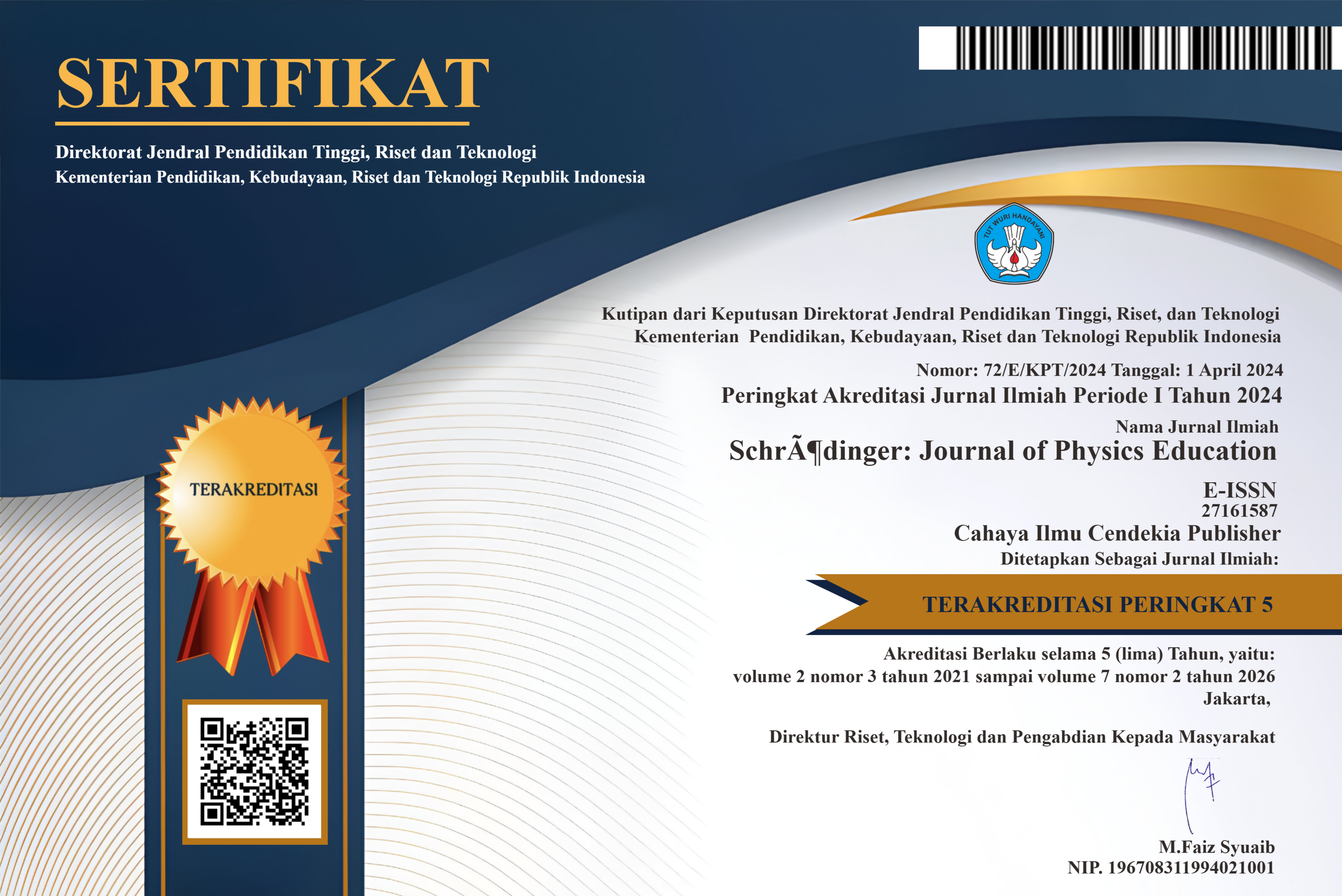Critical Thinking Ability: Analysis of Flat Mirror Reflection Material
Abstract
Research Objectives: The aim of this study was to analyze students' critical thinking skills in the reflection material on plane mirrors. The instrument used in this research is a matter of critical thinking skills
Methodology: This type of research uses qualitative and quantitative research. With a sample of 84 students. Data were analyzed using the SPSS 23 program to obtain the mean, mode, median, maximum and minimum.
Main Findings: Based on the results of this study, students' critical thinking skills are still low. Because students are less enthusiastic in the learning process, students also do not respond optimally to these problems, the student's concept understanding factor is still low, causing misconceptions.
Novelty/Original Research: The novelty in this study is in the form of an analysis of students' critical thinking skills in the material of plane mirror reflection.
References
Undang-Undang RI Nomor 20 Tahun 2003 tentang Sistem Pendidikan Nasional, Jakarta: Sekretariat Negara, 2013.
A. Asrial., S. Syahrial., D. A. Kurniawan., F. Chan., R. Septianingsih., and R. Perdana, “Multimedia innovation 4.0 in education: E-modul ethnoconstructivism”. Universal Journal of Educational Research, vol.7, no.10, pp. 2098-2107, 2019.
A. Astalini., D. A. Kurniawan., R. Perdana., and H. Pathoni, “Identifikasi sikap peserta didik terhadap mata pelajaran fisika di sekolah menengah atas negeri 5 Kota Jambi”. Upej, vol.8, no.1, pp. 34-43, 2019.
J. W. Creswell. “Educational research: planning, conducting, and evaluating quantitative and qualitative research— 4th ed”. Boston: Edwards Brothers, Inc, 2012.
A. Rahim “Strategi Peningkatan Kualitas Pendidikan di Madrasah Aliyah Kabupaten Sidrap: Tinjauan Implementasi Kurikulum Tingkat Satuan Pendidikan”. Lentera Pendidikan: Jurnal Ilmu Tarbiyah Dan Keguruan, vol. 18, no. 2, pp. 218– 235, 2015.
H. Harizon., H. Haryanto., and A. Anisah,, “Pengaruh penerapan model pembelajaran kooperatif tipe make-a match terhadap hasil belajar siswa pada materi larutan elektrolit dan nonelektrolit di SMA PGRI 2 Kota Jambi,” Journal of The Indonesian Society of Integrated Chemistry, vol. 8, no. 2, pp. 47-56, 2016.
H. Haryanto, “Pengembangan instrumen penilaian afektif pada materi laju reaksi di prodi pendidikan kimia fkip Universitas Jambi,” SEMIRATA, 2015.
R. Rustam dan K. Kamaruzaman. “Meningkatkan tanggung jawab belajar melalui layanan bimbingan kelompok dengan teknik proyeksi skripsi”. Jurnal Penelitian Tindakan Bimbingan dan Konseling, vol. 2, no. 2, pp. 1, 2016.
A. Astalini., M. Maison., M. Ikhlas., and D. A. Kurniawan, “Pengembangan instrumen sikap mahasiswa terhadap mata kuliah fisika matematika”. Edusains, vol. 10, no. 1, pp. 46-52. 2018.
T. Tanti., D. A. Kurniawan., R. Perdana., and O. H. Wiza, “Comparison of students’ attitudes toward natural sciences in rural middle schools in Jambi Province,” Jurnal Ta’dib, vol. 23, no. 1, pp. 63-73, 2020.
M. Maison., A. Astalini., D. Darmaji., D. A. Kurniawan., R. Perdana., and L. Anggraini, “The phenomenon of physicology senior high school education: Relationship of students’ attitudes toward physic, learning style, motivation. Universal Journal of Educational Research”, vol. 7, no. 10, pp. 2199–2207, 2019.
P. Pitriah., S. Sutrio., and M. Taufik, “Pengaruh model pembelajaran berbasis masalah berbantuan alat peraga tiga dimensi terhadap hasil belajar fisika peserta didik tahun pelajaran 2017/2018”. Jurnal Pendidikan Fisika Dan Teknologi, vol. 4, no. 1, pp. 43, 2018.
A. Aisyah., J. Jaenudin., and D. Koryati, “Analisis faktor penyebab rendahnya hasil belajar peserta didik pada mata pelajaran ekonomi di SMA Negeri 15 Palembang”. Jurnal Profit, vol. 4, no. 1, pp. 1–11, 2017.
H. D. Young., F. Freedman., A. Roger., T. R. Sandin., and F. A. Lewis. Fisika Universitas Edisi Kesepuluh Jilid 2. Jakarta : Erlangga, 2002.
G. Klein, “Critical thoughts about critical thinking”. Theoretical Issues In Ergonomics Science, vol. 12, no. 3, pp. 210–224. 2012
C. T. Noprinda., and S. M. Soleh, “Pengembangan lembar kerja peserta didik (lkpd) berbasis higher order thinking skill (hots)”. Indonesian Journal of Science and Mathematics Education, vol. 2, no. 2, pp. 168-176.
Y. D. Puspitasari., and T. W. Cahyanti, “Pengembangan modul fisika dasar berbasis scientific untuk meningkatkan higher order thinking skill (hots),” Jurnal Materi dan Pembelajaran Fisika (JMPF), vol. 2 no. 8, pp. 65-72, 2018.
E. Istiyono., D. Mardapi., and S. Suparno. “Pengembangan tes kemampuan berpikir tingkat tinggi fisika (pysthots) peserta didik SMA”. Jurnal Penelitian dan Evaluasi Pendidikan, vol. 18, no. 1, pp. 1-12. 2014.
W. Conklin, “Higher-order thinking skills to develop 21st century learners”. CA: Shell Education, 2012.
A. T. Puspita., and B. Jatmiko, “Implementasi model pembelajaran inkuiri terbimbing (guided inquiry) terhadap keterampilan berpikir kritis siswa pada pembelajaran fisika materi fluida statis kelas xi di sma negeri 2 sidoarjo”. Jurnal Inovasi Pendidikan Fisika, vol. 2, no.3, pp. 121 – 125, 2013.
I. F. Permanawati., A. Agoestanto., and A. W. Kurniasih, “The students critical thinking am posing learning model viewed from the students’ curiosity”. Unnes Journal of Mathematics Education, vol. 7. no. 3, pp. 147–155, 2018
M. John., J. M. Molepo., and M. Chirwa, “How do learners conceptualize plane mirror reflection? a case study of grade 11 south african learners,” Int J Edu Sci”. vol. 13, no. 2, pp. 221-230, 2016
P. Kowalski., and A. K. Taylor, “Reducing students’ misconceptions with refutational teaching: for long-term retention, comprehension matters”. Scholarship of Teaching and Learning in Psychology, vol. 3, no.2, pp. 90-100, 2017
Copyright (c) 2023 Erda Purwanti, Heldalia Heldalia

This work is licensed under a Creative Commons Attribution-NonCommercial 4.0 International License.
Authors who publish with this journal agree to the following terms:
- Authors retain copyright and acknowledge that the Schrödinger: Journal of Physics Education is the first publisher licensed under a Creative Commons Attribution 4.0 International License.
- Authors are able to enter into separate, additional contractual arrangements for the non-exclusive distribution of the journal's published version of the work (e.g., post it to an institutional repository or publish it in a book), with an acknowledgment of its initial publication in this journal.
- Authors are permitted and encouraged to post their work online (e.g., in institutional repositories or on their website) prior to and during the submission process, as it can lead to productive exchanges and earlier and greater citation of published work.






.png)
.png)








.png)
.png)
.png)







